Bulletin – June 2011 Electronic Trading and the Australian Foreign Exchange Market
- Download the article 242KB
Abstract
The introduction of electronic broking to the foreign exchange market in the early 1990s signalled the start of a process of innovation that has driven significant change. This article looks at the evolution of electronic trading in the global foreign exchange market and focuses on its impact on the behaviour of banks globally and in the Australian market.
Introduction
Electronic trading has been a significant factor behind a number of changes in the structure of the foreign exchange market and the way the market operates. These developments include improvements in the price discovery process, a concentration of activity among a relatively small number of large global banks, a blurring of the traditional activities of different market participants, a marked increase in the activity of non-bank participants and the emergence of new market segments.[1]
This article starts by describing the evolution of electronic trading in foreign exchange and its impact on the global foreign exchange market. It then discusses the extent to which changes in the behaviour of banks and their customers at the global level are evident in the Australian market.
The Evolution of Electronic Trading in Foreign Exchange
Until the introduction of electronic broking systems in the early 1990s, price discovery and trade execution occurred predominately over the telephone. A dealer looking to establish or offset a foreign currency position would typically contact several other dealers by telephone to obtain quotes.[2] While dealers broadcast quotes for foreign currency on electronic information systems used by market participants, these were for indication only. Relative to price discovery today, this iterative bilateral process could be slow and was less transparent. Nevertheless, the bulk of trades between dealers were conducted on this direct bilateral basis.
Dealers also used brokers as intermediaries to transact indirectly with other dealers in the interdealer market. These transactions were also conducted over the telephone. Dealers could place bids (to buy) or offers (to sell) with the brokers for specific amounts and the brokers would communicate the current market price to other dealers. By providing a venue for price discovery, each broker eliminated the need for the iterative price discovery process required in direct trades between dealers. However, as the brokers were effectively matching buyers and sellers and did not provide liquidity themselves, there was no guarantee that liquidity would be available to match a dealer's interest. In addition, dealers using brokers did not know the identity of their counterparty at the time of execution. If the executing dealer was unable to deal with the counterparty due to credit limits, or other issues, the trade had to be ‘switched’ by the broker to a new counterparty. Confirming that the trade had been switched to an acceptable counterparty could take time.
Electronic trading in the foreign exchange market effectively began in the interdealer market with the introduction of electronic broking systems provided by Reuters (in 1992) and EBS (in 1993). Demand for these services came from institutions participating in the interdealer market looking for efficiency gains they were already realising from electronic trading in other markets, in particular the equity market. The electronic broking systems offered by Reuters and EBS largely replicated the role played by the existing brokers (now differentiated by the term ‘voice brokers’) but provided an enhanced service. The platforms displayed, in real time, the best bid and offer as well as the depth of the market, based on the orders posted by participating banks.[3] As each bank entered counterparty credit limits into the systems prior to trading, the post-trade credit problem encountered when using the voice brokers was eliminated. The two broking systems greatly improved transparency of the price discovery process thereby facilitating more efficient offsetting of net foreign currency positions in the interdealer market.
The adoption of electronic trading through Reuters and EBS was swift. Data for the US market indicate that close to half of all interdealer transactions, by value, were executed electronically by 2005 (Graph 1, left panel). More recent data for the UK market indicate a similar figure. These aggregate figures obscure considerable variation both by instrument and by reporting entity. The penetration of electronic trading is higher for spot transactions than for other types of transactions and significantly higher for some dealers than others.
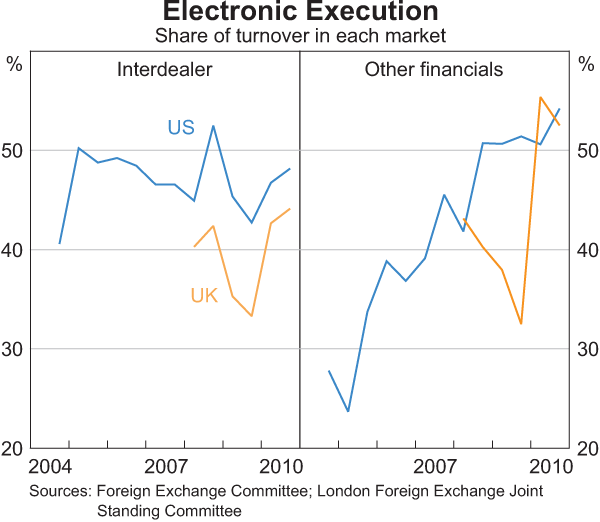
Until around 10 years ago, corporate and financial customers of banks did not have direct access to the price discovery process in the interdealer market and were generally subject to considerably less attractive pricing than was available to their banks. The introduction of the electronic broking systems did not improve access for this segment of the market as participation was limited to banks for some time. However, in the early 2000s, developments in electronic trading began to transform the trading relationship between banks and their customers.
One key development was the decision by a number of large global banks to develop internal proprietary trading platforms for foreign exchange and to provide their more sophisticated financial customers, including hedge funds and other banks, with access to them. In contrast to the electronic broking platforms, which provide a venue for matching trades between many possible counterparties, the providing bank was counterparty to every transaction on its proprietary platform. The decision to develop these platforms was taken partly in response to demand from customers and partly as a defensive step given the emergence of alternative trading venues. But, most importantly, these systems were seen as being instrumental in increasing market share and improving internal risk management. It was realised that electronic trading would transform the economics of the trade process and that scale would become increasingly important. Given the very large investment required to develop and maintain these systems, this approach only made commercial sense for the largest of the banks active in the foreign exchange market.
These proprietary bank trading systems, known as single-bank platforms, gave customers direct access for the first time to streaming price quotes and guaranteed access to liquidity. These systems facilitated straight-through-processing of transactions by automating post-trade confirmations, trade allocation and settlement. They also provided customers with real-time information on all parts of the trade process. Access to this technology reduced the cost for customers of executing and managing their foreign exchange business.
The single-bank platforms enabled the providing banks to capture and analyse information in real time about the foreign exchange business they were transacting. This in turn enabled the banks to develop highly automated approaches to matching offsetting customer business internally and to managing the residual net foreign currency positions. This development has become known as the internalisation of customer flows. To the extent that foreign exchange business can be internalised, banks have less need to offset positions in the interdealer market (Nightingale, Ossolinski and Zurawski 2010). This has reduced the cost to the banks of providing guaranteed liquidity to their customers over their trading platforms.
Another important development at this time was the emergence of multi-bank electronic platforms for foreign exchange. These platforms met a demand from non-bank firms for access to pricing from multiple sources. Some of these platforms operated a ‘request-for-quote’ market in which participants seeking liquidity could request quotes from participating banks for specific amounts at a point in time. The multi-bank request-for-quote platforms effectively replicated the traditional interdealer direct approach to price discovery, but using a more efficient electronic process. Other multi-bank platforms operated limit-order books like the Reuters and EBS broking systems, with streaming prices from multiple sources. Some of these platforms allow non-bank participants to also post prices. As a result, non-bank participants need not trade with a bank through these platforms but can deal directly with other non-banks.
The direct access of non-bank customers to electronic trading platforms was also facilitated by the increased use of technology within the prime brokerage businesses of the global banks (King, Osler and Rime forthcoming).[4] Prime brokerage for foreign exchange first appeared in the mid 1990s but was initially focused on hedge fund business. In the early 2000s, prime brokerage businesses started to expand their foreign exchange coverage, a process facilitated by new market technologies dedicated to the foreign exchange prime brokerage process. By 2005, both Reuters and EBS had introduced products that provided customers of prime brokers with direct access to their matching platforms. For the first time, smaller banks and non-bank financial institutions could directly access the liquidity and pricing available to the largest foreign exchange dealers on these two platforms. Data collected by the London Foreign Exchange Joint Standing Committee indicate that almost 30 per cent of turnover in spot foreign exchange in late 2010 was conducted by clients of prime brokers.
Another significant development was the emergence in the early 2000s of retail aggregators (King forthcoming). These are internet-based businesses that aggregate small retail foreign exchange transactions into parcels large enough to execute at wholesale market prices on the same platforms available to banks and other institutional participants. Like the single-bank proprietary platform providers, retail aggregators look to match much of their customer business internally. Retail aggregators offer retail participants wholesale pricing, typically through a margin trading model.[5] While the traditional clients of retail aggregators were individual investors, small professional proprietary trading firms appear to be a growing part of the client base.
The access of non-bank financial institutions, corporate entities and retail investors to electronic trading platforms, and the advantages of using those platforms, have also driven a significant increase in the share of customer-related foreign exchange business that is conducted electronically. Data from the United States and the United Kingdom show that the share of trading between banks and their financial customers conducted electronically increased steadily from less than 30 per cent in 2004 to more than 50 per cent by 2010 (Graph 1, right panel).
The increased penetration of electronic trading in the foreign exchange market has led, directly or indirectly, to several important changes in the way the market is structured and operates:
- The increased efficiency and transparency of price discovery delivered initially
by the electronic broking systems and then by the single-bank and multi-bank
trading platforms have driven a marked decline in transaction costs, as measured
by the difference between the price at which participants can buy and sell
a currency at a point in time, known as the bid-ask spread (Graph 2).
Graph 2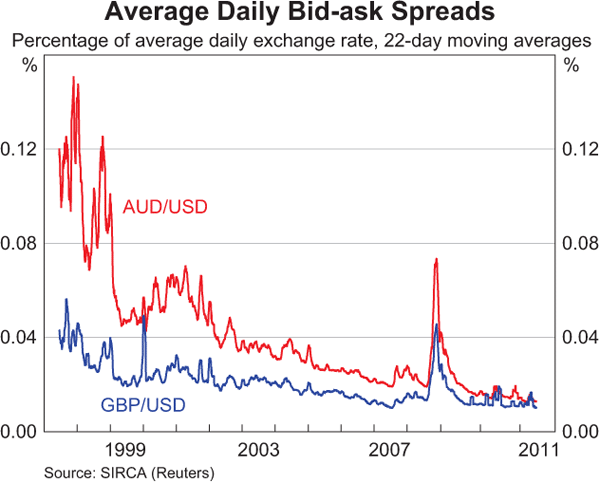
- Price discovery now takes place across multiple venues, a development sometimes described as ‘liquidity fragmentation’. In principle, liquidity fragmentation could make price discovery less efficient. However, market participants can now aggregate real-time price streams from multiple venues and execute on any one of them, effectively treating multiple markets as one. Some have also argued that the ability to post prices for a single trade across multiple venues creates the perception of greater market liquidity than is actually available. The implications of this ‘liquidity mirage’ are not entirely clear.
- There has been a marked increase in the concentration of foreign exchange activity
across the books of a relatively small number of large global banks (Gallardo
and Heath 2009) (Graph 3). This reflects, to a large extent, the impact
of the single-bank platforms on the distribution of foreign exchange business.
It is notable that the most recent surveys of market concentration indicate
a modest decline in concentration as other global banks look to emulate the
success of the early movers using this model (Euromoney 2011).
Graph 3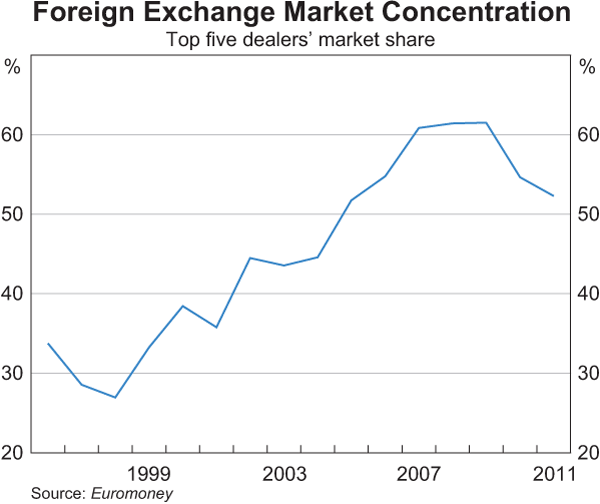
- Increasingly, banks are sourcing foreign currency liquidity for their customers from the large global banks. In some cases, this can involve an arrangement known as white labelling, where a bank provides streaming prices to its customer through a proprietary electronic interface. The streaming prices appear to be from the customer's bank but are, in fact, being provided directly but anonymously by another bank. In other cases, banks have become customers of the global banks for some foreign currency liquidity, particularly in the major currency pairs, but they continue to provide liquidity directly to their customers and to other banks, including the global banks, in their domestic currencies.
- There has been some breakdown in the distinction between the traditional interdealer and customer markets. With direct electronic access and, where required, prime broker sponsorship, some non-banks can now directly access pricing and liquidity that was traditionally only available to banks. In addition, there has been some blurring between the roles of banks and their customers. As noted, many banks now participate in the foreign exchange market as customers of the largest banks while some non-banks now post bids and offers on electronic platforms, effectively competing with banks as market makers.
- There has been a significant increase in the volume of foreign exchange business
undertaken by dealers with their customers, which include other financial
institutions, such as hedge funds, and non-financial institutions (Graph 4,
left panel). Greater access to both single-bank and multi-bank platforms,
broader support from prime brokers and reduced transaction costs are among
the factors behind this trend. The increase in the volume of customer business
is also reflected in a rise in the share of total foreign exchange activity
globally that is executed by dealers with their customers (Graph 4, right
panel). However, this increase also reflects the increasing internalisation
of customer business by the large dealers; a given volume of customer business
will now lead to less activity between dealers than it would have 10 years
ago.
Graph 4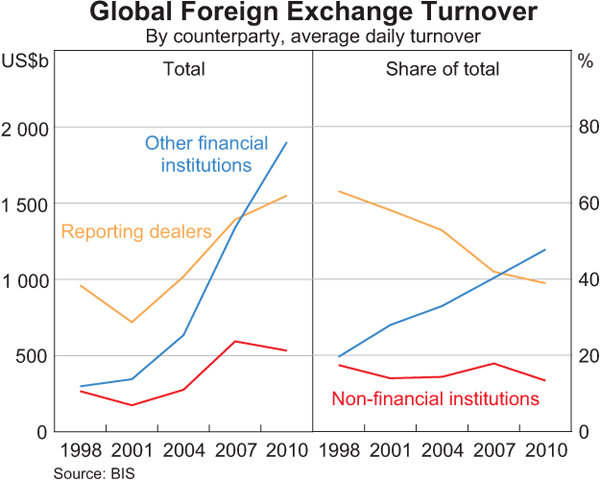
- Electronic trading has also enabled new customer market segments to develop. As noted earlier, retail investors have become an increasingly important part of the market. This is particularly true in Japan where retail margin trading has generated large enough foreign exchange flows to help explain developments in specific exchange rate pairs (Terada, Higashio and Iwasaki 2008; D'Arcy and Zurawski 2009). More recently, attention has increasingly focused on the role of high-frequency traders, for whom the ability to trade electronically is a precondition. Although the development of high-frequency trading was noted as an important new market segment before 2007 (Galati and Heath 2007), there appears to have been particularly strong growth in this market segment between 2007 and 2010 (Nightingale 2010; King and Rime 2010).
The Australian Foreign Exchange Market
The developments outlined above are well documented at the global level and are clearly evident in data from large financial centres such as New York and London. This section looks at data on activity in the Australian foreign exchange market to see to what extent these same trends are evident.
As is the case globally, there has been an increase in concentration of activity in the Australian market over the past decade. In 1998, 16 dealers accounted for more than 90 per cent of turnover in Australia. In 2010, that same market share was accounted for by just 10 dealers. Interestingly, the consolidation has occurred entirely within the foreign bank dealer community. While this is partly the result of some foreign banks leaving Australia and others being involved in merger activity, it also reflects the concentration of business facilitated by electronic trading at the global level discussed above. The foreign banks with the largest market share in Australia are the same firms that have the largest global market shares (Euromoney 2011).
The five domestic banks that are among the largest local foreign exchange dealers do not appear to be losing market share to the large global banks. The market share of the domestic banks has fluctuated mostly between 40 and 50 per cent over recent years, lower on average than in the late 1990s but comparable with the first half of the 1990s (Graph 5). In a sense, this is surprising. While the large Australian banks are important liquidity providers in Australian and New Zealand dollars, and all provide electronic trading options for their customers, it is not obvious that they are well placed to employ the same foreign exchange business model used by the large global banks. The ability of the domestic banks to maintain significant market share would appear to reflect the importance of the relationships they have with their domestic client base. Another factor could be the relatively small size of the investor community in Australia that trades foreign exchange on an automated basis, such as hedge funds and high-frequency trading firms.
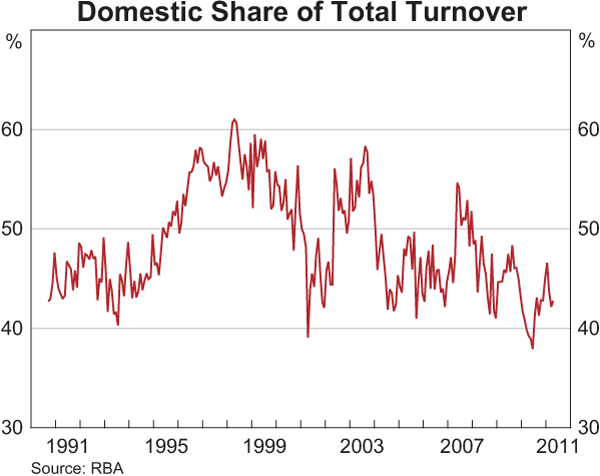
The difference in approach of the large domestic and large foreign banks is reflected to some extent in survey data on foreign exchange execution methods collected as part of the BIS Triennial Survey. Disaggregated data for Australia show that foreign banks in Australia execute a significantly greater portion of their trades across electronic trading platforms than domestic banks. The distinction is clearest for spot transactions, which are most likely to be traded electronically, in both the interdealer and customer markets (Graph 6).
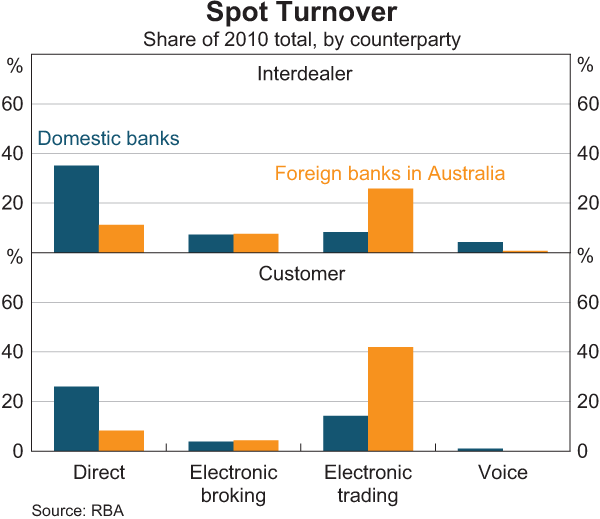
While the strategic focus of foreign exchange businesses within the large domestic
banks varies, the banks, as a group, appear to have chosen to maintain a focus
on servicing their local client base, which includes large exporters and importers
as well as large asset managers. As a result, domestic banks dominate activity
with local customers and other banks operating in Australia (Graph 7).
They also have significant relationships with offshore institutional customers
based around their expertise in Australian dollar denominated products and,
in some cases, their expertise in regional financial markets. It is likely,
however, that Australian banks have become customers of the large global banks
for some currencies for which they do not have such an advantage. New customer
segments, such as retail margin trading and high-frequency trading do not appear
to have been as important for the Australian market as they have been for the
global market over the past five years or so
(Nightingale
et al 2010).
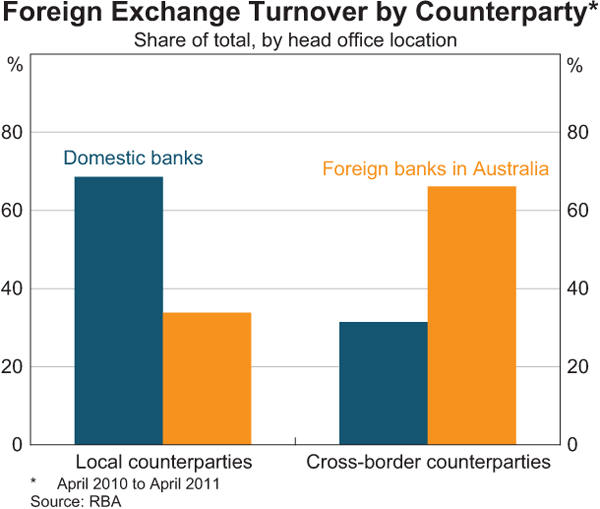
In contrast, foreign banks in Australia trade more actively with cross-border counterparties, and growth in cross-border trade has been a particularly important driver of turnover growth in Australia over the past four years. A significant share of interdealer trades by foreign banks are also reported to have been conducted with related parties, which are likely to be other entities belonging to the same banking group (Graph 8). This share has also grown significantly over the past four years, and is consistent with the increased ability of large global banks to manage their risks at the international level, a development enabled by improvements in technology.
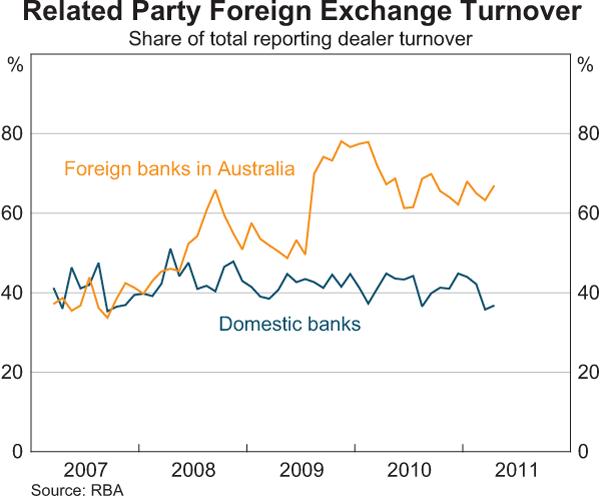
Conclusion
Developments in electronic trading technologies over the past two decades have been an important driver of change in the global foreign exchange market. For banks, three key developments have been a marked increase in the concentration of foreign exchange activity, a change in the relationship between banks in the interdealer market and a significant increase in the volume and share of business conducted with non-bank customers.
In the Australian market, these developments are apparent in turnover data for foreign banks as a group. There has been some concentration of market activity among foreign banks in Australia. The growth in turnover for these banks has been driven by cross-border trades with related parties in recent years, and these trades are more likely to be executed electronically than they are for local banks. Against this backdrop, Australian domestic banks have largely maintained their market share because of their significant and long-established relationships with the domestic customer base and their comparative advantage in making markets in Australian and New Zealand dollars.
Footnotes
The authors are from Financial Markets Group and would like to thank Alexandra Dwyer and Vicki Newman for their valuable contributions. [*]
Price discovery is a term often used to describe the process of establishing the best price at which a financial asset, in this case foreign currency, can be bought or sold at a point in time. [1]
The term ‘dealer’ includes both commercial and investment banks. [2]
Both Reuters and EBS platforms were structured as ‘limit order books’ composed of orders by participating banks for specific amounts at specific prices. Depth of market refers to the amount of interest to buy and to sell at each price point. [3]
Prime brokerage is an arrangement between a bank and a customer, typically a financial institution such as a hedge fund, in which the bank provides the customer with a range of services in return for a fee. These services can include the provision of a line of credit, access to market liquidity in the bank's name, collateral management, and clearing and settlement services. A prime brokerage relationship is a precondition for most non-bank entities to have direct access to electronic markets. [4]
In a margin trading model, the retail investor places a deposit with the broker in a margin account. The broker lends additional funds to the investor against the security of the funds in the margin account. The investor can then establish positions in the foreign exchange market up to the sum of their own funds and the funds provided by the broker. If the investor's position sustains revaluation losses, these will be set off against the funds in the margin account and the investor will be required to deposit additional funds. The broker protects its exposure to the investor by ensuring the position is unwound prior to the loss exceeding the margin account balance. [5]
References
D'Arcy P and A Zurawski (2009), ‘Japanese Retail Investors and the Carry Trade’, RBA Bulletin, March, pp 1–8.
Euromoney (2011), ‘FX Survey 2011’, Euromoney, 42(505), pp 84–88.
Galati G and A Heath (2007), ‘What Drives the Growth in FX Activity? Interpreting the 2007 Triennial Survey’, BIS Quarterly Review, December, pp 63–72.
Gallardo P and A Heath (2009), ‘Execution Methods in Foreign Exchange Markets’, BIS Quarterly Review, March, pp 83–91.
King M and D Rime (2010), ‘The $4 Trillion Question: What Explains FX Growth Since the 2007 Survey?’, BIS Quarterly Review, December, pp 27–42.
King M, C Osler and D Rime (forthcoming), ‘Instruments, Players and the Foreign Exchange Trading Environment’, in J James, IW Marsh and L Sarno (eds), The Handbook of Exchange Rates, John Wiley & Sons, Inc.
Nightingale S, C Ossolinski and A Zurawski (2010), ‘Activity in Global Foreign Exchange Markets’, RBA Bulletin, December, pp 45–51.
Terada T, N Higashio and J Iwasaki (2008), ‘Recent Trends in Japanese Foreign-Exchange Margin Trading’, Bank of Japan Review, No 2008-E-3.